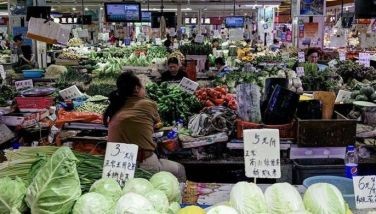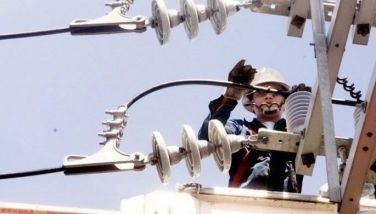Memoir of a study of the Philippine economy during the Japanese occupation

Sometimes a topic of peripheral importance to a career becomes a turning point for an interesting adventure. This is exactly what happened to an incidental study that I made on the Philippine economy during the Japanese occupation.
In 2003, my wife and I took a vacation in the Washington D.C. area. It was a visit to a place which was home to us for 13 years after having served at the UP and with the government.
We stayed with our daughter in Vienna, Virginia, a suburb of Washington D.C. For a few days, familiarizing with old haunts and places sufficed to amuse me. But before long, I was taking down notes at the US Archives and the US Library of Congress.
“Philippine history reclaims my time.” Reading about historic events and documents about Filipino search for nationhood, I got myself completely immersed on a day to day basis. Since my wife had by that time been rendered less mobile by her physical ailments and had stayed home mostly with my daughter, I took a disciplined subway ride to the US Library of Congress. At night and during weekends, we drove out and ate out a lot.
After two weeks of this routine research at the Archives and the Library of Congress at their Washington D.C. headquarters, I shifted research to the US Archives II which is located in the outskirts of Washington. This was a demanding drive along almost one third of the Washington beltway from Vienna to Maryland’s other end close to the University park. Archives II housed many records on the Philippines.
“The war economic damage paper.” One of the things I discovered in the Library of Congress was a declassified US document on two years of Japanese occupation, prepared in 1944. It was thin and yellowed. The article more appropriately belonged to the Archives section than to the section of articles, monographs and books about the Philippines. But it was there, brittle, delicate, and aging with time, all in typescript.
This document was pieced by US war intelligence, presumably for use for the eventual re-conquest of the Philippines. For me, however, it was the start of another mental adventure. I studied the work of those who studied the economy before and immediately after independence.
On return to Manila, I reviewed the Philippine census data of 1938, the work of the Cornell project of Professor Frank H. Golay who tried to estimate the various sector issues of the Philippine economy. I consulted again the pioneering work of William Abraham who undertook the first Philippine national income accounts for the Central Bank then.
From the US records of discussion of US war damage in the Philippines, I got useful information. These works gave estimates of output but had no measure of the war years of Japanese occupation. More important, I studied US data on Philippine war damage that arose out of the work of the Philippine-American War Damage Commission. (The US paid war damage compensation to owners of property damaged during the war after independence.)
I read on the historical writings about the Japanese occupation. Most of them were anecdotal and were related to battles and personages. But disappointingly, there was little hard data.
Historian Teodoro Agoncillo’s well known book about the occupation was more about quoting documents and recounting events and anecdotes committed to historical memory. Benito Legarda Jr.’s recent work was on Filipino sufferings under the cruelties of the occupier’s acts. Certainly, war brings on infinite anguish and immeasurable human grief. It is the economic and physical costs that are quantifiable.
A.V.H. Hartendorp’s recounting of business and economic history – in his book published by the US Chamber of Commerce when he was editing its Philippine journal – was interesting for my purpose in that it collected and published information from documents and he copiously quoted from official sources. He was tuned to data information and that was very helpful.
“Revelation and hiatus.” The result of this work was “The Philippine economy during the Japanese occupation, 1941-1945.” I gave a seminar on this study at the UP School of Economics at which Professor Ricardo Jose of the UP History Department, an expert on the period, commented on my findings. My retired colleague-professors, Amado A. Castro and Agustin Kintanar Jr. also contributed to the discussion.
As a consequence of the seminar, the Philippine National Historical Commission asked to publish the work. Ambeth Ocampo, then head of the commission, wrote me a letter to that effect. None of the staff of the commission followed me up on it. I got fully occupied as my wife suffered a stroke in 2005 and her incapacity required my daily attention for five years until her death in 2010.
I shared my paper with Professor Richard W. Hooley, a former colleague at UP, who had moved to the University of Pittsburgh and who continued his research interest on Philippine development. Dick Hooley thought well of my estimates. To provide his own check, he did estimates of his own of the war year output (which he had not done earlier) using his methods and measurement of output on Philippine long term growth. He is one of the few who had truly worked on hard data about the Philippines. And this helped encourage me that I had done a useful study.
Recently, Professor Jeffrey G. Williamson, another former colleague who is a retired Harvard professor of economic history, recently read the paper. His reactions reminded me of Hooley’s. They are colleagues whose opinions I highly regard.
“Rediscovery.” The UP School of Economics puts on the internet for notice of other scholars all our discussion papers. Eventually, the paper would get serious notice from other sources.
One day, Marcel Boldorf, a professor at the University of Ruhr-Bochum working on World War II economic issues in Europe, and Geoff Huff, an Oxford scholar researching on Japanese war financing in Southeast Asia, thought of organizing an economic history conference on the German and Japanese occupations of countries in Europe and in Asia. They asked if I could present my study in their planned conference.
The plan was to hold the meeting in South Africa. That gave me visions of wild animals – elephants, lions, giraffes, wildebeests, rhinos and hypos – roaming the savannahs. But the plan came out to be implemented as part of a joint conference of the European and Japanese business history professional associations in Paris last week. The change in vision and experience is drastic, but who would not want to be in Paris at any time?
My email is: [email protected]. Visit this site for more information, feedback and commentary: http://econ.upd.edu.ph/gpsicat/
- Latest
- Trending































